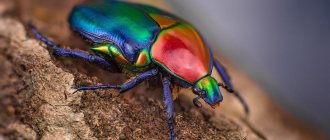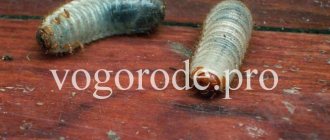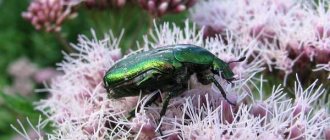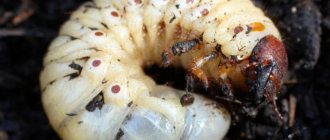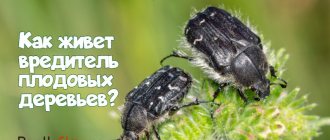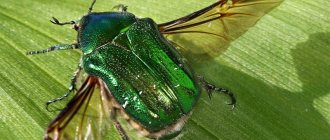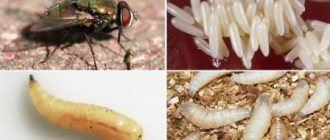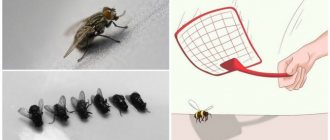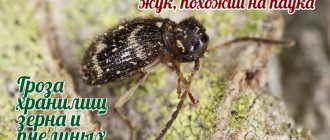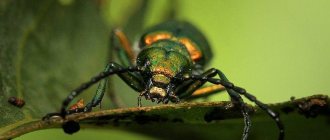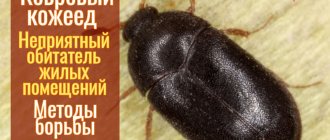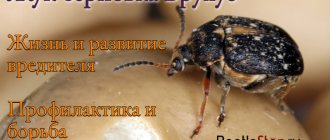A small object rapidly flies through the air, hits an obstacle and falls onto the road. A metallic sheen is visible in the dust. What is this? Bullet? Upon closer inspection, it turns out that it is a beetle. But they don't fly that fast! In the sun it shines and shimmers, as if made of bronze. It seems that scientists have managed to invent a miniature flying robot spy.
Don’t be surprised, this is not a fantastic machine; nature can create things that are not so outlandish. Here is an ordinary bronze, which can be found in almost all corners of the globe.
What does a beetle look like?
You can see beetles on warm and sunny May or summer days, when many beautiful and fragrant plants bloom in gardens, forest edges, meadows and clearings. Insects fly from flower to flower, attracted by the smell of nectar.
Most bronzes are black, but due to the complex structure of the covers, light hitting them is refracted and creates different shades, often with a metallic tint. These can be green, blue, copper-red, purple, brown colors with a beautiful shine.
Description
Bronze beetles are beetles with an oblong-oval and wide body and a small head, which is directed forward and lowered slightly down. Depending on the species, the insect grows up to 8–30 mm in length. On the head of the insect there are black antennae consisting of 10 segments, eyes and mouthparts. The dorsum is most often covered with hairs, but can be smooth.
The wings of bronze birds are well developed. They are distinguished from most lamellar beetles by the presence of special cutouts on the elytra. Through them, the insect releases its wings to rise into the air, while the elytra themselves remain tightly folded on the back.
Another feature of these insects are light scaly dots on the pronotum, chest, elytra, and legs. They come in different sizes, sometimes merging and covering most of the body.
The structure of the legs helps the beetles dig the ground - there are teeth on the outer edges of the fore tibia.
The insect larvae are large, C-shaped - their body is widened in the middle and curved like a hump. The integument is soft and translucent, white. The head capsule of the larvae is sclerotized and has 4 antennae.
Only some species of larvae have eyes. The legs are long, vaguely divided into segments. There are no claws on the limbs. Bronze larvae can move on their backs.
Types of beetles
In our country, the bronze is distributed throughout the entire European territory, with the exception of Crimea and the territories north of Karelia. It is also found in Siberia and the Far East.
Golden bronze
The most common species in Russia. The length of the golden bronze is 13–22.5 mm. Color changes due to lighting. The back is shiny, most often with a bright green tint, reminiscent of emerald or with a golden-green tint.
Bronzovka shaggy
The beetle is matte black in color, 8–13 mm long. There are white or yellow spots or stripes on the back. The body below is covered with thick gray-yellow hairs; there are fewer of them on the back.
Marble bronze
The insect is 19–27 mm long. The body is shiny black-bronze with a greenish tint. The head and pronotum are covered with large dots. In gardens, the beetle lives under old and rotten trees.
Bronzovka smelly
The insect lives in areas with a warm climate, near forest edges and meadows with rich vegetation. This is a beetle 8–12 mm long with a black shiny body covered with white specks and hairs. As the insect ages, it loses its hairs.
Pest control measures
Since the stinking bronze bug develops, spends the night and winters in the earthen cover, it is advisable to treat the soil in the garden with hexachlorane to a depth of 5 cm. In the daytime, a mechanical method of pest control should also be used. A litter or hard surface is spread under the tree, then the plant is shaken, after which the fallen beetles are collected and immediately destroyed. It should be borne in mind that in hot weather the beetles are very mobile and can quickly take off, so before shaking the tree, it should be well sprayed with water. You can also collect beetles from low plants by hand.
The fight against the stinking bronze beetle is complicated by the fact that this beetle is capable of covering quite long distances in flight, so it is often elusive. If there are a large number of beetles, during flowering you can spray the plants with a solution of the Calypso preparation.
Features of life
The insect development cycle takes 2 years, in the northern regions - 3 years, and an adult beetle (imago) lives 1 year. Before becoming an adult, the bronze fly goes through the stages of egg, larva and pupa.
Most bronzes emerge from hibernation when many fruit trees have already bloomed.
Mating of insects occurs in mid-summer. Females lay 15–20 eggs under rotten stumps, in manure and compost heaps. After a few weeks, voracious larvae appear. They do not touch plants, but feed on organic debris.
The larva enters the pupal stage only the next year. During this time, she molts 2 times and spends the winter in hibernation. With the onset of summer, the larvae form a cocoon around themselves from their own secretion and turn into pupae, and after 2 weeks an adult beetle emerges from the cocoon.
Insects are active in warm and sunny weather. In cloudy and cool weather, they hide in a shelter or sit motionless on flowers. A bronzefish sitting on a flower seems clumsy and can be easily picked up. But she comes out of this state unexpectedly, moves to the edge of the flower and quickly takes off. In the air, the insect maneuvers in large circles and is difficult to catch, but when it bumps into a person or objects, it cannot go around the obstacle and falls to the ground.
Online reading of the book The Life of Insects. Stories of the BRONZOVKA entomologist
There is a lilac alley in my garden. In May, the lilac bushes are covered with many flower clusters, and then a cheerful insect festival begins here. They flock here from everywhere, and among them there are many beautiful bronzebacks.
Golden bronze (x 1.5).
The golden bronze may not be elegant enough, but it is superbly colored and shimmers with gold. Who has not seen this beetle, which looks like a large emerald, when it sits on a rosehip flower, standing out with its brilliant color against the delicate background of the petals! He sits motionless, day and night, enjoying the aroma of the flower, and at the same time having lunch. Only the too hot sun brings the beetle out of its stupor, and it flies away. Just by the look of this lazy creature, you can say that the bronze is a glutton. But what will she find on a rosehip or a rose? There is no way that this beetle can sustain its life on such meager food.
Copper bronze (x 2).
At the beginning of August, I place a dozen and a half bronzefish in the cage, which have just broken open their cocoons. They are bronze on top, purple below, these are copper bronzes. I feed them what I have at this time of year: pears, plums, melon, grapes. Sitting on the food and immersing their heads in it, they gorge themselves day and night, in the shade and in the sun. Having descended under the soft, spreading fruit, they lick the juice. No other activity! All the time is devoted to enjoying food. On a hot day, it’s so good to sit under a sweet plum and suck its juice. Not a single bronze car moves. The beetles have been feasting for two weeks now, and they are still not satiated. It is not often that you see such a long period of feeding; you will not find it even among voracious dung beetles. The scarab feasts without a break for no more than a day. And my bronzes have been eating pears and plums for two weeks now, and it’s not noticeable that they are full. When will the feast end and worries about the family begin?
Bronzovkas will not have family worries this year: they are postponed until next year. Strange delay! It is not like the ordinary habits of insects rushing to attend to family affairs. Now is the time for fruit. And the bronze woman enjoys delicious food without being distracted by household chores. Meanwhile, the heat is becoming more and more merciless. The bronzefish in my cage stop eating and bury themselves in the sand. They are not attracted to the ripest and sweetest fruits: it is too hot.
September arrives with its moderate warmth. Bronzefish come out of their torpor, appear on the surface of the fishing line and begin to eat. They eat the melon peels and grapes I put in, but in moderation. When it gets cold, they hide in the sand again. There they spend the entire winter, protected only by a layer of sand several fingers thick. And under such a thin cover they endure the most severe frosts. I thought they were chilly, but they turned out to be very hardy.
March had not yet ended when the revival began again. My broncos have come to the surface, climbing the net, wandering around the cage when it’s sunny and warm. It gets fresher, and they bury themselves in the sand. What should I treat them with? There is no more fruit. I give them honey in a paper cup. They eat it, but without much desire. I offer them dates. They love this beautiful thin-skinned tropical fruit. I feed them dates until the end of April, when our cherries ripen.
So we returned to their usual food - local fruits. But now the beetles eat them very sparingly: the time of gluttony has passed. Soon I notice that the time for laying eggs is approaching: the beetle weddings have begun. A pot filled with half-rotten leaves is placed in the garden. First one or another female bronzebird crawls there and remains there for some time, hiding in the leaves. Having finished her business, she climbs to the surface. Another week passes, then another. The beetles wander around the cage, and then hide in the sand and die. Their offspring are in a pot with rotten leaves. June has not yet ended, and I find eggs and young larvae in a pile of leaves.
Only now can I explain the strangeness that once greatly confused me. Digging up a large pile of plant humus in a shady corner of the garden, I found in it in July and August cocoons of bronze beetles with beetles enclosed in them. Here and on the same days I saw young beetles in the pile, and nearby very young larvae. Before me was something paradoxical: children appeared before their parents, before those beetles that had not yet emerged from the cocoons lying in the same heap.
Observations made in the cage explained this mystery to me: the bronze beetle lives for a whole year, from one summer to the next. Cocoons break open in the summer heat, in July and August. The bronze that emerges from the cocoon is engaged only in eating, and leaves laying eggs for next summer.
Having overwintered, it appears in the first days of spring, but there is no fruit, and last year’s glutton becomes more abstinent: it feeds on flowers. In June, she lays eggs in heaps of humus, next to cocoons, from which young beetles will emerge a little later. Thus, eggs of one generation appear earlier than those beetles that have not yet emerged from the cocoons, that is, earlier than beetles of another generation. Among the bronze birds that fly during one summer, two generations must be distinguished. One of them is an overwintered one; in the spring it lives on roses, lays eggs in June and dies. Another is the beetles that appeared in July and August. They feed on fruit and will remain for the winter; They will lay eggs in June next year.
June has the longest days and is the time for egg laying. In the shade of the pine trees, near the garden fence, lies a huge pile of all kinds of garden waste, especially leaves. From here I collect humus for my cages, and this same pile is a paradise for the larvae of bronze beetles. Here they find both abundant food and warm shelter even in winter: the slow rotting of leaves and plant debris heats the pile.
Several species of bronzebacks live in this pile. The most common species is the copper beetle, which provides me with most of my information about these beetles. Larvae of the golden bronze and small speckled stinking bronze are also found here.
The bronze is smelly (x 2).
Let's see what's going on in the pile of leaves at nine or ten in the morning. Sometimes females make you wait a long time, so let’s be patient.
Here comes the copper bronze. She flies in wide circles over the heap, choosing a place where it is easier for her to get into the heap. He sits down, digs with his forehead and legs and hides in a heap. Where will she go there? At first, the direction can be determined by ear: you can hear the leaves rustling, among which the beetle makes its way. Then there is silence: the bronze has reached the damp, rotting leaves located in the depths of the heap. Only there will she lay an egg, and the larva that hatches from it will find tender food near it. Let's leave the beetle for now and return to it in about two hours.
Let's think about what you just saw. A magnificent beetle, just basking on the rose petals, leaves the flower and buries itself in the rot. Why is he doing this? The bronzefish knows that its larva will feed on what is disgusting to itself. Overcoming her disgust, or perhaps not feeling it, she plunges into rot. Is she guided by memories of her own childhood? No, she is guided by a blind, irresistible attraction - instinct.
Let's return to the pile of humus. We know approximately where the bronze moved inside the heap. After searching, we will eventually find her eggs. They are randomly scattered, lying one at a time and always near tender, rotting leaves. The testicle looks like an ivory ball. Its diameter is about three millimeters.
Bronze larva (x 1.5).
The larva hatches after twelve days. It is white, with short sparse hairs. She is easy to raise in a cage. I put it in a tin box: it keeps the rotten leaves moist for a long time. And that's all my concern. You just need to replenish the supply of provisions, and the larva will pupate in a year. There is not so little trouble with any insect as with the larva of the bronze fly, although it is very voracious. The larva grows quickly and a month after hatching already reaches half of its final size. I wanted to calculate how much the larva eats. To do this, I measured her feces accumulated in the box. I got 11,978 cubic millimeters. In one month, the larva ate food several thousand times its body volume.
The larvae of the bronze fly eat continuously and turn dead leaves and stems, already destroyed by rotting, into powder. The veins would remain intact for a long time in the rotting leaves. The larva also eats these slowly rotting remains: with its strong jaws it splits them into fibers and then gnaws them. In her intestines they turn into dough, quite suitable for fertilizing the soil.
One of the most active producers of black soil is the bronze larva. When she pupates and I examine her box for the last time, I am amazed at the amount of substances she has processed: it can be measured in bowls.
The bronze larva deserves attention for another reason. It is thick, two to three centimeters long, convex on the back and flat on the ventral side. Its dorsal side has deep transverse folds in which sparse hairs stick out. The ventral side is smooth, and the dark contents of the intestine are visible through its thin skin. The legs are small, weak and do not at all correspond to the size of the body.
The larva can curl up into a ring. This is a position of rest, more often of self-defense in case of anxiety. Then it rolls up so tightly that you are afraid to break it when you try to unwrap it. If you leave it alone at this time, it straightens up and quickly crawls away.
A larva placed on a table crawls on its back, holding its legs in the air. This is the usual method of movement for bronze beetle larvae. Turn such a larva onto its stomach, and it will again turn onto its back and crawl again in this strange position. It cannot be forced to crawl with the help of its legs: either it will curl up in a ring and lie motionless, or it will crawl on its back. She moves, trying to bury herself and hide from persecution. She crawls quite quickly: highly developed muscles form the dorsal ridges, and these provide good support even on a smooth surface, thanks to the hard hairs sticking out on them. The larva sometimes rolls over onto its side: with the rounded surface of its back, it is not difficult to lose balance. With a sharp effort, she returns to her previous position and continues to crawl on her back, swaying slightly to the right and left. The larva's head rises and falls, and its jaws seem to be chewing, apparently trying to grab some kind of support.
Let's give them this missing support, but such that it does not hide what we want to see. Let's take a glass tube that gradually tapers towards one end. At the wide end there is room for the larva, and here it crawls on its back. Then the larva enters that part of the tube whose width is equal to the thickness of its body. Now she crawls as she has to - up or down with her back. I see how she moves with the help of the spinal ridges: waves seem to run along her back, and the hairs sway like rye on a windy day.
The larva's head swings correctly. The ends of the jaws serve as a crutch, resting against the walls. Twisting the tube between my fingers, I give it different positions, but my legs remain inactive, even when they touch the walls of the tube. Their significance in the movement of the larvae is negligible. What are they used for? We will see this now.
The larva moves into humus in the same way as in a glass tube. Finding itself in a more or less dense mass, having support on all sides at once, it crawls in any position. If we saw her crawling through a pile of leaves, we would not find anything unusual in her method of movement. But we put it on the table and are surprised at its strange habit - crawling on its back. But this only depends on the fact that she has only one point of support here - from below. And when its dorsal rolls - the main organ of movement - touch this only support, the larva will crawl, and of course, in an overturned position, lying on its back. This is how other thick larvae with short legs would move on the table: the larvae of the cockchafer, rhinoceros, and anoxia, if they could turn over on their backs.
Cocoon of stinking copper bronze (x 1.5).
Beetles lay eggs in July. At this time, the overwintered old larvae are preparing for pupation. Bronze cocoons are quite elegant. They are rounded-ovoid, almost the size of a pigeon egg. The stinking bronze, the smallest of the bronzes that inhabited my pile of humus, has cocoons no larger than cherries.
Cocoon of golden bronzer (x 1.5).
The cocoons of large species of bronze beetles are so similar that I cannot distinguish them. However, in the golden bronzer, the cocoon is mostly covered with randomly placed pieces of excrement, and in the copper bronzer, it is covered with scraps of rotten leaves. The reason for these differences is not the difference in the talents of the builders: the material surrounding the larva during the production of the cocoon is not the same. It seems to me that the Golden Bronzewort willingly pupates among its waste, while the Copper Bronzewort prefers less polluted places. In golden and copper bronzes, the cocoons are not attached to anything from below. The stinking bronzefish builds its cocoon on some solid support, for example on a small pebble; but if she doesn’t find such support, she will do without it.
Cocoon of copper bronze (x 1.5).
The cocoon, smoothly polished inside, is hard and durable, but you cannot immediately recognize what its walls are made of. The bronze larva excretes a lot of feces: where it crawled among the rot, brown lumps are scattered in abundance. Before pupation, she secretes much less of them: she accumulates soft sticky dough inside her body - an excellent material for construction. Look at the end of its abdomen before starting to build the cocoon. You will see a large dark spot: the supply of feces is visible.
Golden bronze pupa (x 1.25).
Here's the proof. I place one adult larva at a time in small jars, ready to cocoon. To build a building you need supports, and I put something in each jar: chopped cotton, pieces of paper the size of lentils, parsley seeds, radish seeds - whatever I have on hand. The larvae burrow into these unusual substances. There is no earth or clay in my jars, and the larva can build a cocoon only with the help of its own cement.
But will she build here?
Yes, she builds, and she builds very well. A few days later I see cocoons in jars, the same size and as beautiful and durable as those that I found in my humus heap. And they are much more elegant. Built in cotton, covered with cotton wool, made among pieces of paper, they look covered with snow. Covered with parsley and radish seeds, they resemble nutmegs. Under the outer layer of cotton wool, pieces of paper or seeds there is a wall made of brown cement. The regularity of the cocoon suggests that its outer lining is not an accident. You think the same thing when you see the cocoon of a golden bronze, plastered on the outside with grains of excrement. One might think that the larva collects around itself - at its own choice - lumps and, to give strength to its structure, encrusts the cement walls with them.
No, that's not true at all. There is no mosaic work here. With its round back, the larva pushes around itself the soft substance in the midst of which it finds itself. Distributes and evens it out by applying pressure with the body. And then gradually, point by point, he fastens it together with his cement. The result is an ovoid cell, the walls of which are thickened with more and more layers of plaster: the larva adds them until its reserves of feces are depleted. Everything soaked in them strengthens and becomes the wall of the cocoon without much participation from the larva: it only turns around and secretes its “dough.”
It is impossible to trace all this work in its entirety: the larva is hidden from our eyes. One can only glimpse the most important thing in her techniques. I select a still soft, unfinished cocoon and use the tip of a penknife to make a small hole in its wall. What's inside? The larva curled up into a ring. Then she restlessly pokes her head into the hole I made. And after that it curls up so that the ends of its body touch. And now she already has a lump of putty, just delivered by the gut.
Now you can find out and understand the meaning of the larva’s legs. Completely unnecessary for crawling, they turn out to be invaluable assistants in the construction of a cocoon. These are small hands that grab the lump presented with their jaws, twist and turn it over. And the larva separates particles from it and puts them in place. As if acting with a shovel, she takes a little cement with her jaws, mixes it with the same jaws and places it on the edges of the break. He presses it with his forehead and flattens it. Having used up the lump of cement, the larva again curls up into a ring and secretes a new lump of feces, which is picked up by the jaws, followed by the legs.
We saw little as the larva quickly repaired the hole in the cocoon wall. But this tells us what happens in nature under normal conditions.
What damage do beetles cause?
The main food of bronzes is flower nectar , and for the larvae - plant debris . But adult individuals can gnaw leaves on flowering ornamental plants and trees, damage young shoots, stamens and pistils on flowers. Beetles eat overripe fruits and berries: mulberries, grapes, raspberries, cherries. The scale of such damage is insignificant; bronze beetles do not pose a serious threat to crops and plants . Flowers of ornamental and fruit crops are most often damaged by insects that emerge from hibernation early. Therefore, no special protective measures have been developed against bronze insects.
Bronze spots appear less frequently in well-groomed areas. It should be taken into account that gardens with few old, sick and dry trees and rotten stumps are not attractive to insects.
You will learn more about bronzes from the video.
Family Buprestidae
Subfamily Chrysochroinae
Pine borer (Chalcophora mariana).
Although I came across goldfish in the Svetlopolyansky forest, they were clearly made at a rubber bullet factory. The first one hit me in the arm - I almost let go of the steering wheel out of fear, and the second one hit me in the forehead with all its might (at first I didn’t even understand what happened), and then bounced away from me onto a log lying next to the road and pretended to be resting in the sun . That's where I took a picture of her.
